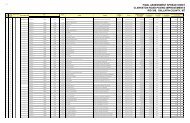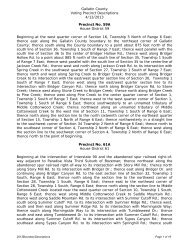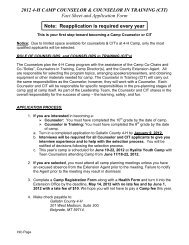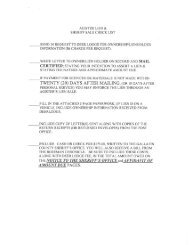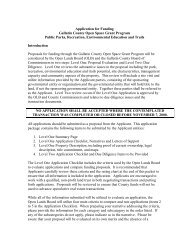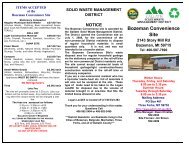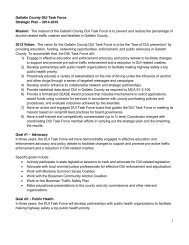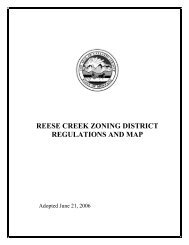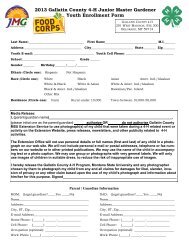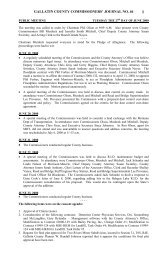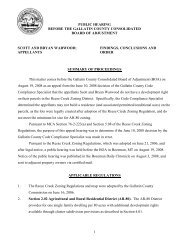Scientists offer advice for combating Bozeman pine beetle outbreak
Scientists offer advice for combating Bozeman pine beetle outbreak
Scientists offer advice for combating Bozeman pine beetle outbreak
You also want an ePaper? Increase the reach of your titles
YUMPU automatically turns print PDFs into web optimized ePapers that Google loves.
FOR IMMEDIATE RELEASE<br />
CONTACTS:<br />
Amy Gannon, State Entomologist,<br />
Montana DNRC (406) 542-4283<br />
Kevin Wanner, Assistant Professor, Entomology<br />
Montana State University (406) 994-5663<br />
Ryon Stover, <strong>Bozeman</strong> City Forester<br />
(406) 582-3200<br />
September 16, 2008<br />
<strong>Scientists</strong> <strong>offer</strong> <strong>advice</strong> <strong>for</strong> <strong>combating</strong><br />
<strong>Bozeman</strong> <strong>pine</strong> <strong>beetle</strong> <strong>outbreak</strong><br />
BOZEMAN, Mont. – A coalition of entomologists and <strong>for</strong>esters tracking <strong>Bozeman</strong>’s<br />
mountain <strong>pine</strong> <strong>beetle</strong> (Dendroctonus ponderosae Hopkins) <strong>outbreak</strong> say proactive<br />
spraying of trees that haven’t been attacked is the best method <strong>for</strong> safeguarding<br />
native and ornamental <strong>pine</strong> and spruce trees in the city.<br />
“Un<strong>for</strong>tunately, once a tree has been attacked, it’s going to die,” said Amy Gannon,<br />
state entomologist with the Montana Dept. of Natural Resources and Conservation<br />
(DNRC). “Spraying trees that show signs of <strong>beetle</strong> infestation will not save them.”<br />
Gannon visited <strong>Bozeman</strong> last week to assess the <strong>beetle</strong> <strong>outbreak</strong> with <strong>Bozeman</strong><br />
City Forester Ryon Stover, along with Kevin Wanner, MSU Extension Entomologist,<br />
DNRC Service Forester Curt Tesmer, Montana Dept. of Agriculture entomologist Ian<br />
Foley, and MSU Extension diagnostician Richard Miller. The agencies and their<br />
insect specialists are collaborating on recommendations <strong>for</strong> <strong>Bozeman</strong> residents,<br />
who <strong>for</strong> months now have been watching their non-native Scotch <strong>pine</strong> turn red and<br />
die. A number of other species have also been affected – ornamental spruce, limber<br />
<strong>pine</strong>, lodgepole <strong>pine</strong> – and Gannon said native ponderosa <strong>pine</strong> and non-native<br />
Austrian <strong>pine</strong> are highly susceptible as well.<br />
Fighting the infestation requires doing battle on two fronts, said Stover: Preventing<br />
healthy trees from being attacked, and managing dead and dying trees to interrupt<br />
the <strong>beetle</strong>s’ life cycle and reduce their numbers.
“Mountain <strong>pine</strong> <strong>beetle</strong> larvae will continue to develop in dead standing or downed<br />
trees, including small pieces of firewood,” said DNRC’s Tesmer. Larvae become<br />
adult <strong>beetle</strong>s in the summer, he said, emerging from their natal tree around mid-<br />
July to take flight and locate living trees. The adults bore into a healthy host, lay<br />
eggs, and the cycle begins anew.<br />
“It can get expensive, but people who have <strong>beetle</strong>-killed trees need to consider<br />
burning, chipping, burying or removing all of the infested wood prior to June 15,”<br />
said Gannon. “Placing a tarp over infested wood doesn’t reliably kill mountain <strong>pine</strong><br />
<strong>beetle</strong>s in our climate.”<br />
Stover and Tesmer said they are looking into the possibility of a disposal yard where<br />
<strong>Bozeman</strong> residents can drop off infested logs.<br />
Healthy trees can be protected by spraying them next spring with any one of several<br />
commercial brands of insecticide, Wanner said. “Just make sure bark <strong>beetle</strong>s are<br />
among the listed species on the label. Specialized equipment and precise<br />
application are critical, so hiring a certified applicator is a good idea.” Thoroughly<br />
covering the tree trunk is a key to success, he said; applications must be made on<br />
all sides of the tree from ground level up to a five-inch caliper.<br />
Another successful tool <strong>for</strong> preventing attacks is the chemical Verbenone, which<br />
mimics the “no vacancy” message that <strong>beetle</strong>s send out after an infested tree has<br />
become too crowded to support any newcomers. The synthetic hormone is sealed in<br />
a permeable plastic pouch – the pouch is stapled to the tree.<br />
“Verbenone can be fairly effective in low populations,” Gannon said. “In residential<br />
areas it’s best to apply 2 – 4 pouches per tree. Be sure to follow all label<br />
instructions.” Verbenone can be ordered directly from the two companies that<br />
manufacture the stuff: Pherotech (604-940-9944) and Synergy (604-454-1121).<br />
Gannon said both companies have excellent Web sites with detailed in<strong>for</strong>mation.<br />
Identifying trees under attack by mountain <strong>pine</strong> <strong>beetle</strong>s isn’t difficult. As they bore<br />
into the trunk, the tree produces popcorn-shaped nodules of sap, called “pitch<br />
tubes,” in an ef<strong>for</strong>t to repel the insects. Small piles of wood dust collect near the<br />
base of the tree.<br />
“Infested trees may remain green during the fall and have green crowns, but if you<br />
see pitch tubes and wood dust, that tree is done <strong>for</strong>,” said Stover, “no treatment is<br />
going to save it.” The feeding activity of the larvae will disrupt the tree’s circulatory<br />
system, he said. Beetles also carry a blue-stain fungus which has a detrimental<br />
effect on the host tree.<br />
In <strong>Bozeman</strong>, mountain <strong>pine</strong> <strong>beetle</strong>s thus far have gone after ornamental Scotch<br />
<strong>pine</strong> and some spruce, said Stover, though all species of <strong>pine</strong> – ponderosa,<br />
lodgepole, limber, Austrian, mugo and whitebark – are susceptible to attack.<br />
Beetles target trees greater than five inches in diameter.



